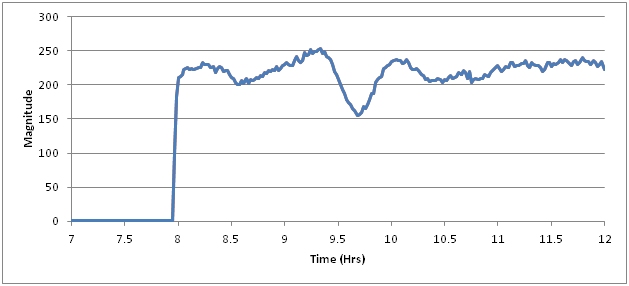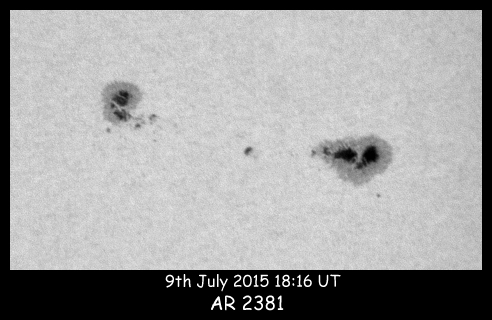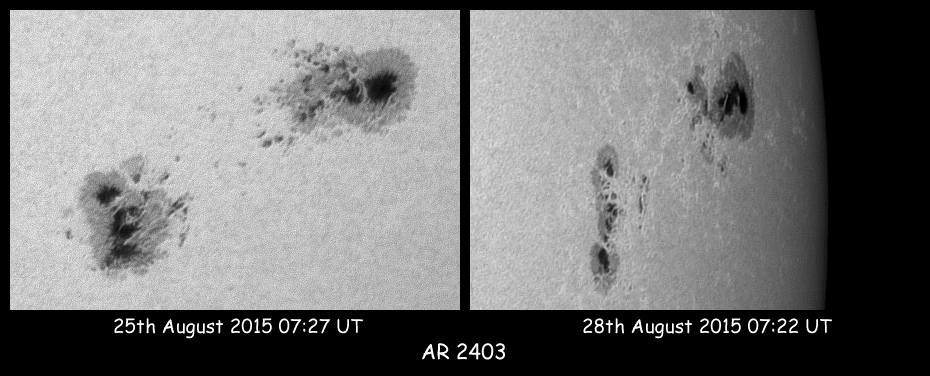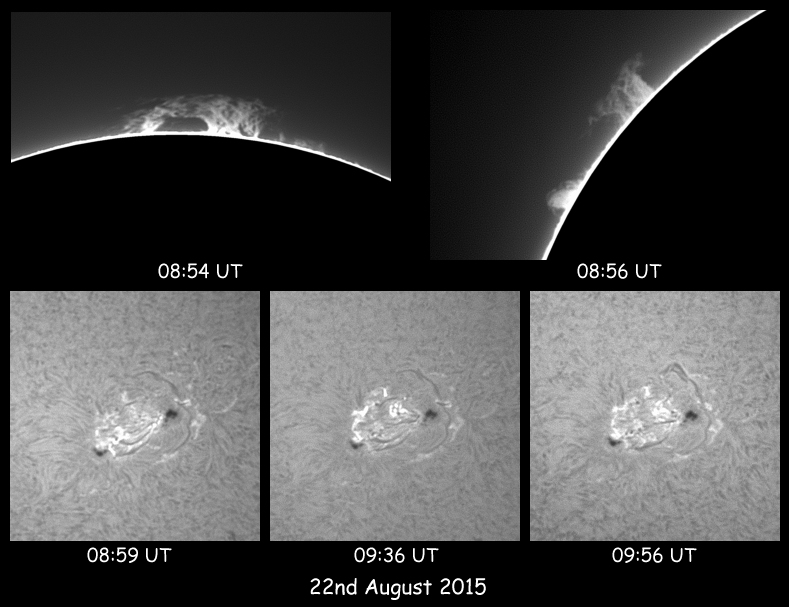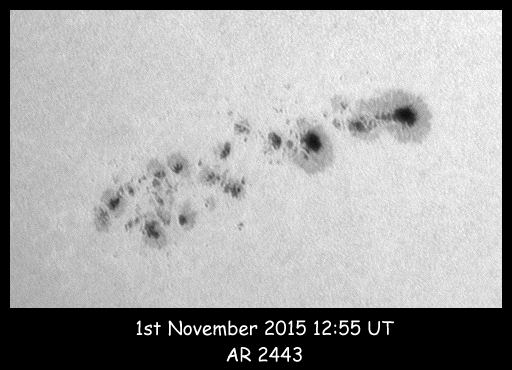|

Each
month a summary of sunspot activity is written and forms part of a
report sent to the Solar Section of the British Astronomical
Association (BAA)
and to The
Astronomer. Follow
the links below to read a
page summary of
sunspot activity. The McIntosh Sunspot Group Classification is used for
sunspot group descriptions.


January
2015
The
observation
on the 2nd showed
that all but one of the eight groups seen were in the southern
hemisphere.
Indeed the southern hemisphere dominated during the month – a
trend that has
persisted since April 2013. The largest group on the 2nd was AR 2253 at
5°S/1°
of type Eac with an area of 460 millionths. The main sunspot was in the
leading
part of the group – there were a couple of smaller nearby
sunspots and
additional penumbral sunspots in the following part of the group. AR
2253 was
seen with the protected naked eye.
The
next observation on the 10th
also had eight groups. AR 2257 was at 8°N/320° of type
Dac with
an area 210
millionths and it comprised of a collection of several penumbral
sunspots
spread out in both latitude and longitude. AR 2259 was also present at
15°S/241°
of type Eao and area 360 millionths – here the larger of the
two
sunspots was
at the following position. In addition four small Axx/Bxo were seen the
northern hemisphere to the east of AR 2257. By the 11th AR 2257 had
grown
slightly to 300 millionths while AR 2259 was slightly smaller. The
following
sunspot of AR 2259 had split by the 14th when the group was near the
central
meridian.
From
the middle of month the
number of groups reduced with just three being seen on the 17th, 23rd
and 24th.
During this period the largest group was AR 2266 of type Dao at
5°S/163° with
an area of 190 millionths on both the 19th and 20th when near the
central
meridian. It then decayed as it was last seen as an Hsx sunspot on the
25th
close to the western limb. On the 23rd AR 2268 had appeared around the
eastern
limb at 9°S/47°. By the following day it was seen a
type Fko
with an area of
410 millionths. It was of a similar form on the 25th but by the 27th it
was of
type Fac through the addition of a few penumbral sunspots and many
pores
between the leader and follower sunspots. The number of groups seen on
the 27th
had increased to seven.
Hydrogen Alpha:
The
most notable prominences based on 4
observations was on the 11th when two detached prominences were visible
– the
one on the SW limb was quite rectangular in shape while the other on
the NE
limb comprised a slim band of hydrogen separate but parallel to the
limb
stretching for over 10°. A small bright prominence appeared at
13h
15m UT close
to the solar equator on the W limb but cloud prevented further
observation.
Several medium length filaments were seen on each observation including
a
semi-circular one near the middle of the disk on the 24th. Plage was
seen
around AR 2257 on the 10th and 11th.


February
2015
Activity
during
the month showed
quite a reduction compared to previous months – in fact R at
60.0
was at its lowest
since September 2013. As well as fewer sunspots groups, the size and
complexity
of sunspot group was also lower. There was also a dominance of the
northern
hemisphere over the southern hemisphere for the first time since April
2013.
On
the 2nd two northern groups
were seen, one at 8°N/337° of type Dsi just approaching
the
central meridian.
It was comprised of two small nearby penumbral sunspots and a few
surrounding
pores (the total area being just 90 millionths). With a gap of
15°
to the east
of this group was a Cao group at 12°N/316° where the
irregular
penumbral
sunspot had an area of 200 millionths. NOAA classified these two groups
as just
one active area (AR 2277): examination of the Solar Dynamic Observatory
MDI
magnetogram, showing the magnetic polarity of the solar surface, for
the 2nd
does indeed suggest that both two observed sunspot groups have opposite
polarity thus confirming a single active region. On the 5th there was
still a
lack of sunspots for 10° in the middle of AR 2277 which
increased
to 15° on the
6th due to the decay of sunspots. Just the following part of AR 2277
was seen
on the 8th and 9th.
The
largest group of the month,
AR 2280, was initially seen as a Bxo group on the 2nd at
7°S/282° near the
eastern limb. By the 5th it was type Dac with an area of 120
millionths. More
sunspots appeared within the group by the 6th which appeared slightly
larger by
the 9th when the total area was 330 millionths and type Eac –
the
largest
sunspot was in the leading part of the group. The group had rotated off
the
disk by the next observation on the 15th.
On
the 8th a small penumbral
sunspot was seen near the eastern limb at 13°N/191°. On
the
following day
another group was seen slightly to the south and east. By the 15th the
northern
of these group was a single Hax sunspot and size 90 millionths, while
the
southern was of type Cso, size 60 millionths and at
8°N/189°. Again
NOAA classified
these two groups as one
active area, AR 2282. However, the SDO magnetogram seems to indicate
that these
sunspots should not be classified as one AR as there are distinct north
and
south magnetic polarity for both groups. When seen on the 18th just two
penumbral Hsx sunspots were seen at 13°N/191° and
8°N/189° respectively.
The
last observation of the month on the 23rd
just showed three small groups, two in the north of type Cso at 40
millionths
and Bxo and one in the south of type Hsx.


March
2015
There
was
further reduction in
activity compared to previous months and with higher activity in the
south once
again. No sunspots were seen in the northern hemisphere on each day
between the
7th and 14th inclusive.
The
largest of three groups seen
on the 1st was AR 2293 at 6°N/339° of type Dac and area
80
millionths. At this
group neared the western limb it became type Dao on the 4th with an
area of 140
millionths. It was last seen on the 6th as an Axx group. On
the 7th a compact but complex group was
seen close to the eastern limb. This was AR 2297 at
16°S/195°
which comprised
of several penumbral sunspots, the largest being the following sunspot.
Over
subsequent days, this group grew slightly to have an area of 360
millionths on
the 12th and 13th. It extended in longitude to become type Eac on the
14th when
the follower was still the largest sunspot and when there were many
smaller
sunspots in the leader portion of the group. AR 2297 was seen with the
protected naked eye on the 12th and 14th.
On
the next observation on the
20th showed just one sunspot, AR 2301 at 18°N/65° of
type Hax.
However by the
23rd six groups were present. The largest was AR 2305 at
7°S/6°, type Eac and
area 330 millionths. When seen on the 27th it was close to the central
meridian
when it comprised of an irregular leading penumbral sunspot, one small
following penumbral sunspot and several pores. There were still six
groups
visible on the 27th.
Hydrogen Alpha:
On the 7th a tall spike prominence was seen on
the NW limb with a smaller prominence about 10° to its north.
By
the following
day, the spike had reduced to become a much smaller prominence which
extended a
few degrees on latitude. The other prominence now had a V shape. On the
27th a
π shaped prominence was seen on the SE limb.
Many
filaments were seen on each of five observing days.
Of particular
note was a long filament seen on the 27th in the NE quadrant which had
the
appearance of a pronounced change of direction of about 90°
mid-way
along the
filament. An extensive region of plague was seen around AR 2297 on the
7th and
8th.
VLF:
Although
it was totally cloudy
in
Chelmsford during the eclipse, a dip in the 23.4 kHz VLF signal from
the DHO38
transmitter in German was detected. This is shown in the plot below.
One
characteristic of DHO38 is that the transmitter is switched off for an
hour
between 7 and 8 UT. Around the time of maximum eclipse there was a
symmetrical
dip in VLF signal strength. The start and end times of the dip were
09:22 and
09:59 UT with the minimum strength being at 09:41 UT.
The
minimum strength time did not correspond to maximum eclipse here at the
receiver (09:31 UT) but to the maximum eclipse time at the transmitter
site
near Rhauderfehn, Germany at 09:41 UT. The
average of the start and end dips times is also 09:41
UT.
I’m not sure
why this should be
the case, as
I expecting the minimum time to correspond to the mid-point between
here and
the transmitter.


April
2015
There
was an increase in activity
compared to March, especially in the northern hemisphere. On the 1st,
one of
the two groups seen was AR 2305 which was an Eac group on March 27
– now it was
just a single Hkx penumbral sunspot at 10°S/10°
approaching the
western limb.
It was last seen on the following day. On the 5th, the larger of two
groups seen
was AR 2320 at 13°S/211° of type Dso and 140
millionths: a
compact bipolar
group. Over
subsequent days, more small
penumbral and pores appeared within the group as it became type Eac on
the 8th
and 9th when it crossed the central meridian. AR 2320 then decayed and
it was
last seen as type Cao on the 12th.
Activity
began to increase from
the 11th with the appearance of more groups including the rotation on
to the
disk of AR 2321 of type Eac at 11°N/90°. On the 12th
this group
was of type Ekc
through the presence of a very elongated penumbral sunspot in latitude.
By 14th
this sunspot must have split as the group now consisted on several
medium sized
penumbral sunspots spread over quite a large area in both latitude and
longitude. AR 2321’s area was 540 millionths. The size of the
group began to
reduce as it became more of a typical bipolar group. For example on the
16th it
was of type Eac with an area of 210 millionths. As the group progressed
towards
the western limb, it decayed such that on the 20th it was of type Cso
with an
area of 80 millionths. It was last seen as type Hsx on the 21st and
22nd. From
the 15th to 18th a small group was seen just to the north of AR 2321:
AR 2326
of type Bxo on the 16th and 18th.
Another
of the five groups seen
on the 14th was AR 2324 of type Hkx at 18°N/62°. On the
following day a
following penumbral sunspot appeared to make the group type Dkc
–
it had an
area of 330 millionths. By the 20th, the main penumbral sunspot decayed
to
leave a collection of small penumbral sunspots. The number of sunspots
reduced
as this group neared the western limb and it was last seen on the 24th
as an
Hsx sunspot. Between the 18th and 28th AR 2331 was seen at
9°S/17°. Initially
it was of type Cso before developing to type Esc with an area of 140
millionths
on the 22nd (when near the central meridian). It remained type E as it
progressed towards the limb and also developed a central penumbral
sunspot.
From
the 22nd onwards the number
of groups reduced from eight to just one Axx group on the 29th and 30th
(AR
2334 at 20°S/260°).
Hydrogen
Alpha:
The most impressive prominence
seen during the month was on the 24th and 25th on the NE limb. On the
24th, for
some 15° along the limb a curtain of hydrogen was visible, part
of
which had by
the following day rotated onto the disk to form a prom-filament. At the
northern end of the prominence was a sharp bright edged spike. A much
smaller
curved prom-filament was seen on the 11th, also on the NE limb. Filaments
was quite numerous during the month
based on 7 observations – the most notable were seen on the
6th
(NW quadrant),
14th (NE quadrant) and 18th (NW quadrant). Plage was seen associated
with AR
2320 on the 6th, AR 2321 on the 11th, 12th, 14th and 18th while on the
25th
four regions of plage were seen, two of which were associated with
sunspots
groups (AR 2331 and 2333).
Images:
White light image of AR 2321,
2324 and 2325 from the 18th taken with 105mm ETX, Baader N3.8 Solar
Film and
Imaging Source Camera.
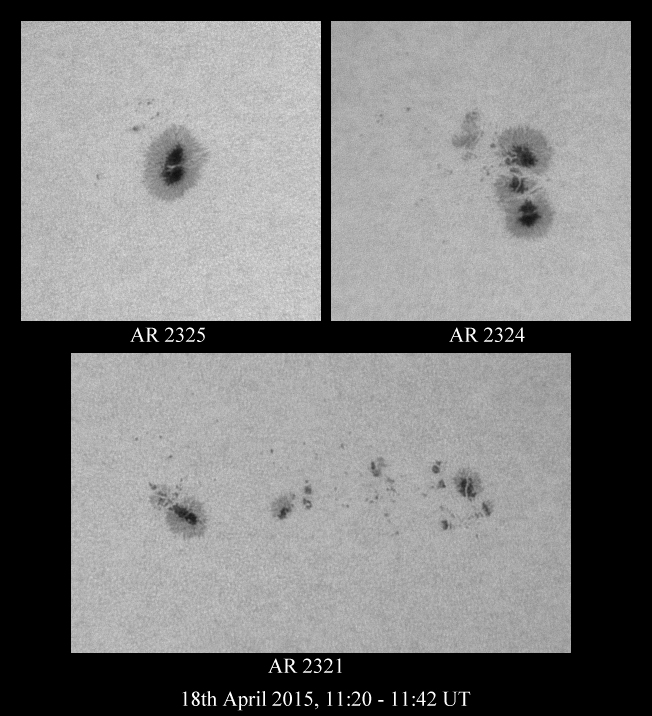


May
2015
Activity
was quite variable
during the month with lower activity at the start and end of the month
compared
with the middle portion. The southern hemisphere was the more dominant
once
again.
The
only group seen on the 1st
was the Dso group AR 2335 at 15°S/193° and close to the
eastern
limb. By the
3rd it has developed two small penumbral sunspot between the leader and
follower and it had an area of 250 millionths. The number of penumbral
sunspots
had increased again by the following day and it also became type Eac
with an
area of 320 millionths. However by the 7th with the group just past the
central
meridian the number and size of sunspot reduced such that the total
area was an
estimated 110 millionths. The next observation on the 11th showed that
AR 2335
was an Axx group close to the western limb.
One
of the other six groups from
the 7th was the largest of the month, AR 2239 at
12°N/129°. On
this date it was
seen as type Fkc, comprising several medium sized sunspots spread
throughout
the group. It had an area of 250 millionths which had increased to 590
millionths on the 11th when the group was near the central meridian. It
comprised several irregular penumbral sunspots mainly at the leader and
follower positions of the group with several other smaller sunspots and
pores
spread throughout the group. AR 2239 was seen at its largest on the
12th at 700
millionths and by the following day it was seen smaller at 430
millionths
through a reduction in the size of the penumbral sunspots. This decay
continued
as the group progressed towards the limb and it was last seen as type
Eac on
the 17th. AR 2239 was seen with the protected naked eye on the 11th as
two
sunspots and as one sunspot on the 12th.
With
the passage of AR 2239 over
the limb, the number of groups seen reduced from a peak of six on the
18th to
one on the 27th and 28th. All of these were small groups.
Hydrogen Alpha:
Two particularly tall prominences
were seen on the 16th – one on the NE limb comprised two
curved
spikes which
leaned towards each other to form a triangular shape while the other
was on the
NW limb which comprised a straight spike prominence with two nearby
shorter
spikes. Both had a maximum height of about 100,000km. The most obvious
Hα
activity based on seven observation were long filaments, especially on
the 3rd,
23rd and 24th. In several cases, the filaments were broken which would
have
otherwise spread at least half way across the solar disk. Plague was
seen
around AR 2335 on the 3rd, around AR 2239 & 2344 on the 16th,
around AR
2344 on the 17th, around AR 2349 on the 23rd and around AR 2349
&
AR 2353
on the 24th.
Images:
White light images below of AR 2339
from the 16th and 17th were taken with 105mm ETX, Baader N3.8 Solar
Film and
Imaging Source Camera. The Hα image below from the 24th was
taken
with a PST and Imaging
Source Camera.
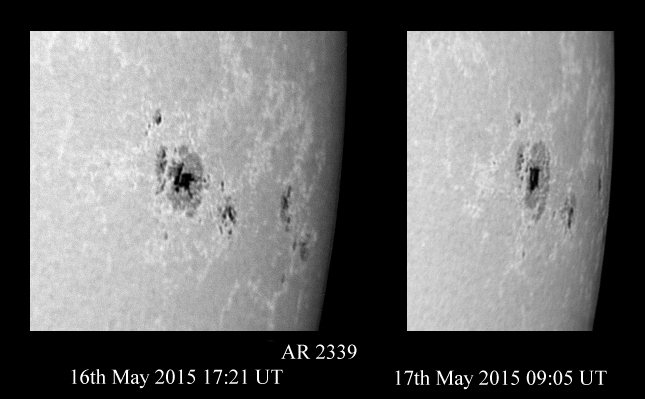
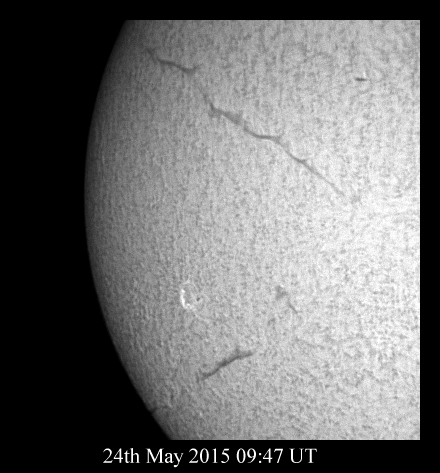


June
2015
A
total of seven groups were seen
on the 6th but all were fairly small: the largest being AR 2362 at
6°N/100° and
of type Dao with an area of 180 millionths. As this group progressed
across the
disk it lost its leading penumbral sunspot and it was last seen on the
11th as
a small Cso group with an area of 30 millionths. One of the three
southern
groups on the 6th was AR 2365 near the eastern limb at 13S/80 and of
type Hsx.
On the 10th a few small surrounding pores could be seen around the
single
penumbral sunspot which had an area of 70 millionths. It was last seen
close to
limb on the 17th as a single penumbral sunspot once again.
The
observation on the 15th revealed
a complex bipolar group, AR 2367 at 19°S/1° of type Eac
and area 300
millionths. The main sunspots comprised of an almost symmetrical leader
with
two nearby penumbral followers. By the following day, the leader had
almost
split into two and more followers had appeared. As AR 2367 began to
decay the
leader became more complex while the followers reduced in size and
number. By
the 21st the group had reduced to 170 millionth even though it was
still of type
Eac. It was last seen close to the western limb on the 23rd. AR 2367
was seen
with the protected naked eye on the 18th.
The
largest group of the month,
AR 2371 appeared around the limb on the 16th as a complex Ekc group at
12°N/302°.
Further sunspots in this group could be seen on the following day as
they
rotated onto the disk. Many of the followers had merged together by the
18th so
that the group comprised mainly of large leader and follower sunspots
– the
total area being 860 millionths. The shape of the follower had changed
again by
the 19th as it became more irregular. By the 21st both the leader and
follower
become less elongated in latitude with both sunspots containing several
umbrae.
Again the shape of both main sunspots changed shape by the 23rd when
the
group’s total area was 1040 millionths. Subsequent
observations showed a
decaying group with an area of just 280 millionths on the 25th and AR
2371 was
last seen as type Eko on the 27th. This group was seen with the
protected naked
eye on the 18th, 19th, 20th (as two sunspots), 21st (two sunspots),
22nd (two
sunspots) and 23rd (two sunspots).
From
the 25th to 27th AR 2371 was
the only group on the disk. The next observations on the 29th and 30th
showed
several small groups near the eastern limb.
Hydrogen
Alpha:
An extensive hedgerow prominence
was seen on the 21st extending along the NW limb.
On
the 29th a small filament could be seen
attached to a prominence on the NE limb – by the following
day, the filament
was much further onto the disk and well as the prominence part being
higher
above the limb. Also on the 29th several nearby spire shaped
prominences were
seen but by the 30th these appeared to have merged to form a single
pyramid
shaped prominence. Many filaments were seen on each of 11 observations.
Of
particular note was on the 19th when a wide dark filament was on the NW
quadrant and a thin multi-component filament in the NE quadrant.
On
the 16th at 18h 05m a bright
region of plague was seen around AR 2371 near the eastern limb - over
the next
15 minutes this formed into two bright spots.
At
the start of the
Hα observation on the 29th at 18:00 UT, three bright
spots were seen around AR 2373 but these had faded by 18:20UT (this
being a C2
flare peaking at 18:07 UT).
Images:
White light images below of AR 2367 from the
17th and AR 2371 from the 17th, 21st, 23rd and 25th were taken with a
105mm ETX
telescope, Baader N3.8 Solar Film and Imaging Source Camera.
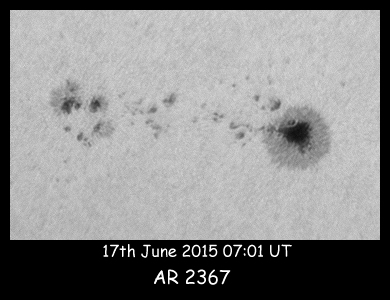
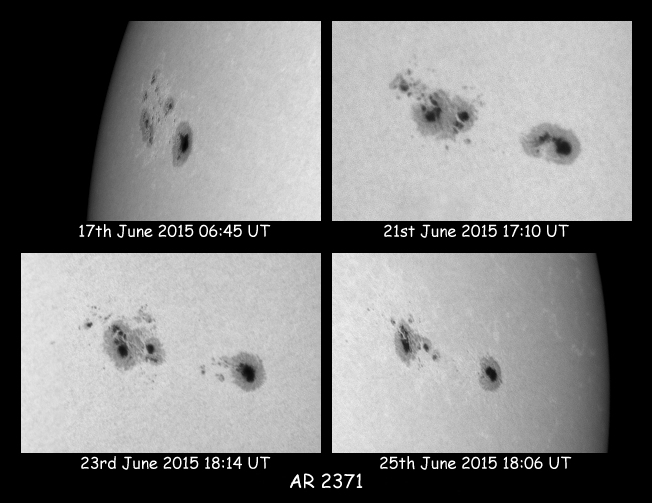


July
2015
All
four groups
seen on
the 1st
were in the east, the largest being AR 2373 at
16°N/143° of type Dao. It
comprised a leading asymmetrical penumbral sunspot and a few small
followers
and it had an estimated area of 180 millionths. Over subsequent days
further
groups appeared such that on the 5th seven were seen in the central and
eastern
part of the Sun. By this date AR 2373 had lost its following penumbral
sunspots
to become a smaller Hsx group – it remained of type when last
seen close to the
limb on the 9th.
One
of the groups that had
rotated onto the solar disk on the 4th was AR 2381 of type Dso at
14°N/73°. By
the following day, several penumbral sunspots had formed to make the
group of
type Dsc with an area of 250 millionths. It was of a similar form and
size on
the 6th. However on the 8th it had become a bipolar group with
asymmetrical sunspots
in the leading and following positions. Its area had also increased to
440
millionths and it was now of type Eai near the central meridian. By the
9th the
following penumbral sunspot had reduced in size slightly. The
longitudinal
extent of AR 2381 lengthened on the 10th and 11th to become an F type
group,
although the group’s size continued to reduce such that on
the 11th it was 260
millionths. AR 2381 was seen with the protected naked eye on the 8th
and 9th.
The
next observation on the 19th
showed a much reduced level of activity which continued until almost
the end of
the month. For example on the 21st, 22nd and 23rd only two small groups
were
seen in the northern hemisphere and no sunspots in the southern
hemisphere.
Similarly on the 25th only two small southern groups were on the solar
disk.
One of these was AR 2390 of type Bxo at 14°S/197°. By
the 27th it had rapidly
developed into a Dac group with an area of 180 millionths. On the
following
day, the leading sunspot appeared to split into several penumbral
sunspots. As
AR 2390 progressed towards to limb on the 31st, it reverted back to
type Bxo.
On the 30th six groups were seen and five on the 31st.
Hydrogen Alpha:
Based on five observations
during
the month, there were no particular striking prominences seen. Several
filaments were seen on each occasion but not were long. Plage was seen
around
AR 2373 on the 9th, around AR 2387 on the 19th and 22nd and around AR
2390 and
2393 on the 31st.
Images:
The
white light image below of AR 2381 from the 9th
was taken with a 105mm ETX telescope, Baader N3.8 Solar Film and
Imaging Source
Camera.


August
2015
Activity
during
the month was
dominated by the presence of two naked eye sized groups: AR 2396 and AR
2403.
AR
2396 at 16°S/37° was first
seen on the 4th as a Dso group with an area of 150 millionths
–
nothing was
seen at this location on the previous day. By the 6th this group had
developed
to type Eac through the appearance of a asymmetrical leading sunspot
which
included several umbrae. There were also several smaller follower
sunspots. Over
subsequent days AR 2396 continued to grow to type Ekc such as on the
8th when
its area was estimated to be 760 millionths – it was also
near
the central
meridian. By the 9th several penumbral sunspots in the following part
of the
group had increased in size to give an overall size of 820 millionths.
The last
observation of AR 2396 on the following day showed that the group had
started
to decay through a reduction in the size of the leading sunspot
–
it was now
660 millionths. AR 2396 was seen with the protected naked eye on the
6th, 7th,
8th and 9th.
Activity
reduced in the days
leading up the appearance of AR 2403 around the eastern limb on the
19th of
type Dsc. For example on the 17th there was just one small Hsx group on
the
disk. Between the
19th and
21st, AR 2403
at 14°S/191° had developed into a collection of many
small
penumbral sunspots
and pores. It was of type Eac and area 350 millionths. By the 22nd a
more
substantial leading sunspot was beginning to form. This rapid
development
continued such that on the following day a more substantial follower
had also
developed – AR 2403 was now a substantial bipolar group of
type
Ekc and area
660 millionths. When next seen on the 25th the group had almost doubled
in size
to 1110 millionths of now type Fkc: there were now two substantial
leading and
following penumbral sunspots each containing many umbrae but only a few
pores
between. The next two observations on the 27th and 28th showed that the
leader
had started to split with a couple of small penumbral sunspots
appearing the
break away while the follower also splitting with the main follower
being very
elongated in latitude. When the group was last seen close to the
western limb
on the 29th the leader was quite reduced in size while the follower had
broken
into small penumbral sunspots. AR
2403
was seen with the protected naked eye on the 21st, 22nd, 23rd, 25th (as
two
naked eye spots) and 26th (as two naked eye spots with the darkest
being
nearest to the limb).
Other
groups seen were modest in
size – the largest being AR 2394 at 13N/77 of type Cso of the
7th
with an area
of 130 millionths.
Hydrogen
Alpha:
On the 8th and 9th a complex
prominence was seen on the NW limb – initially it comprised
two
parts which
merged together on the 9th to form along slender arch stretching for
some 20°
along the limb. Another striking prominence was seen on each day
between the
21st and 23rd, this time on the NE limb. It comprised a partial arch
15° in
length on the 21st before filling out with plenty of structure within
the
prominence on the 22nd (see image below). By the 23rd the arch
structure had
started to disappear being replaced by several pillars. On the 22nd and
23rd
other moderately sized prominences were also seen on the E limb.
Many
filaments were seen on most
of the 10 observations, particularly on the 8th & 9th and the
28th
and
29th. Of particular note was a V shaped filament on the 28th which had
lost it
distinctive shape by the following day. Also on the 28th were two quite
extensive filaments which had the appearance of blobs of hydrogen
rather than
the more normal thin elongated filaments. Both were still present on
the 29th,
although of slightly different shapes.
In
particular plage was seen
around the naked eye sunspot group AR 2403 on the 21st to 23rd On the
22nd and
many small plage regions were seen within the group (see Hα
images below which
were taken before, during and after a C5.1 flare which occurred between
09:09
and 09:39 UT, peaking at 09:21 UT).
Images:
The white light images below of AR 2396 from the
8th and 9th and AR 2403 from the 25th and 28th were taken with a 105mm
ETX
telescope, Baader N3.8 Solar Film and Imaging Source Camera. The
Hα images from
the 22nd were taken with a PST and Imaging Source Camera.
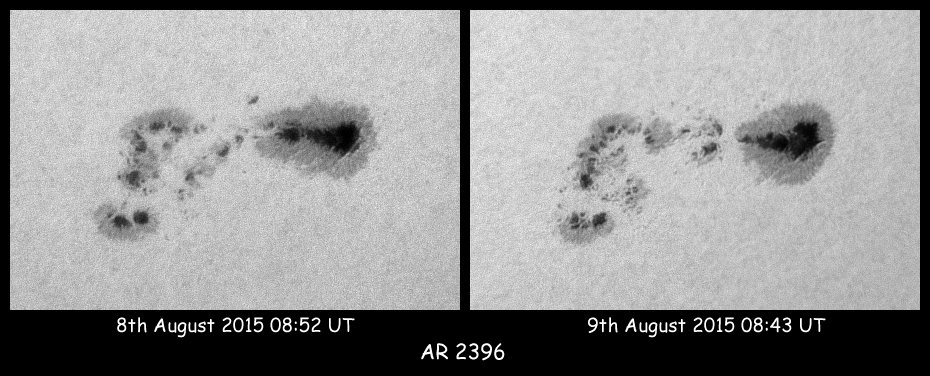


September
2015
Activity
was
quiet during the
first half of the month before increasing particularly through the
development
of naked eye sized group AR 2422.
Just
two small northern groups were seen on the 2nd, 5th and 6th. Additional
southern groups were seen on subsequent observations. Of particular
note was AR
2414 at 9°S/319°. It was initially seen as an Axx
sunspot on
the 9th and 10th
before developing into type Cai on the 11th, where the penumbral
sunspot was at
the following position. This penumbral sunspot had increased in size by
the
following day as well as two small leader penumbral sunspot making the
group
type Eac with an area of 270 millionths. On the last observation on the
13th it
had lost some of its pores to become type Eao.
Also
on the 13th an Hsx sunspot
was seen close to the eastern limb at 14°S/201°. By the
next
observation on the
19th AR 2418 had become type Hhx with an area of 270 millionths and
still a
single sunspot – it was also near the central meridian. It
had
become more
asymmetrical and slightly reduced in size to 220 millionths. When next
seen on
the 24th it was type Hsx again and close to the western limb. AR 2418
was seen
with the protected naked eye on the 19th and 20th.
One
of the six groups seen on the
24th was AR 2422 at 19°S/103° which appeared as a Dac
group with
an area of 140
millionths. By the following day it had developed into an Eac group
with many
penumbral sunspots, the largest being the follower – its area
was
330 millionths.
Further development continued over subsequent days such that by the
27th, with
the group near the central meridian, it attained an area of 630
millionths. It
now comprised two main leader and follower sunspots, the leader being
the more
symmetrical. On the 28th further changes occurred within AR 2422 and it
changed
from being type Eac to Fkc. On the 29th and 30th, with the group
approaching
the western limb, it could be seen that the leader and follower
sunspots had
split into several smaller penumbral sunspots. AR 2422 was seen with
the
protected naked eye as two sunspots on the 27th, 28th and 29th and as
one naked
eye sunspot on the 30th.
Hydrogen Alpha:
An active prominence was seen on
SE limb on the 20th. Initially a small bright plage region was seen
close to
the limb at 09h 20m UT. Then at 09h 30m a small prominence appeared
above the
limb which continued to expand. At
09h
43m another small prominence appeared from the same point on the limb
to make a
bright V shaped prominence. This
then
faded by 09h 47m. The
largest prominence
seen based on 5 observations was on the 26th when an arch type was seen
on the
E limb. Also of interest was a moderately long and wide filament that
was
initially seen on the 20th some 30° off the E limb –
it had a
latitude extend
of 30° and 5° in longitude.
It
was
still
present on the 26th and 27th of a similar size but with a more complex
shaped
boundary. On the
27th two small
regions
of plage were seen just to the W of this filament.
Images:
The white light image below of AR
2422 from the 27th was taken with a 105mm ETX telescope, Baader N3.8
Solar Film
and Imaging Source Camera.
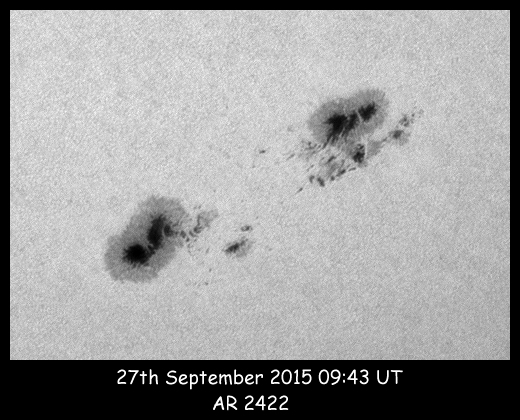


October
2015
Overall activity was lower than
during recent months: both the number of groups MDF and R are lower
than since
January 2011 – an indication that activity is now declining.
The
naked eye
group from
September, AR 2422 at 19°S/103°, was seen progressing
towards at the limb at
the beginning of the month. On the 1st it was of type Fac while by the
3rd on a
single Hsx sunspot was seen near the western limb from the following
part of
the group. The only other significant sunspot group on the 1st was AR
2427 of
type Dai at 18°N/37° with an area of 110 millionths.
The two leading penumbral
sunspots merged to form a Cai group when seen on the 2nd, 3rd and 4th.
Observations on the 8th, 9th, 11th and 14th only showed a few small
sunspot
groups.
The
next
observation on
the 20th
showed four sunspot groups, the largest being AR 2436 at
9°N/110 of type Eac
and area 160 millionths. This group decayed to type Cai and 90
millionths when
next seen on the 25th. The most significant group of the month, AR
2443, was
seen on the 31st as a Fac group at 7°N/313° near the
eastern limb. It had an
area of 530 millionths and it comprised of a string of many penumbral
sunspots
where the larger ones were towards the leading part of the group.
Hydrogen
Alpha:
A rather striking prominence was
seen on the SE limb on the 11th whereby several nearby spikes were seen
together with more horizontal slab of hydrogen towards the south
– this
prominence spanned some 15° along the limb. Although filaments
were seen on
each of the three observations, the most were seen on the 4th. Plage
was seen
around AR 2427 on the 4th.


November
2015
The
particularly cloudy
weather
restricted observing to 6 days where the majority of the activity was
in the
northern hemisphere. The most significant of the three groups seen on
the 1st
was AR 2443 at 7°N/313°. It was of type Fac comprising
a collection of medium
to small penumbral sunspots throughout the group and it had an area of
510
millionths. It
was also seen with the
protected naked eye. This
group was not
seen on the next observation on the 13th when four small or Axx groups
were
seen. The most significant group seen on the 20th was a Dsc group near
the
eastern limb (AR 2457) at 10°N/30°. On the 22nd it was
of the same type and it
had an area of 110 millionths. AR 2457 had reduced to a small Hsx
sunspot by
the 28th. The other two groups from the 28th were AR 2458 at
6°N/358° of type
Dao and area 140 millionths and AR 2459 at 4°N/329° of
type Hsx and area 100
millionths.
Hydrogen
Alpha:
On the 1st an elongated arch
prominence was seen on the eastern limb stretching some 10°
along the limb. The
next Hα observation on the 20th showed several prominences
along the western
limb. Meanwhile on the 22nd a particularly tall and irregularly shaped
prominence was also on the western limb – a tower shaped
prominence was seen
further towards the north. Several filaments were seen on the 20th and
22nd. Plage
was seen around AR 2445 on the 1st, AR 2457 on the 20th and 22nd and AR
2458 on
the 22nd.
Image:
The white light image below of AR
2443 from the 1st was taken with a 105mm ETX telescope, Baader N3.8
Solar Film
and Imaging Source Camera.


December
2015
A
second month
of
particularly
cloudy weather restricted observing to 7 days.
The
larger of two
groups seen on the 1st was AR 2458 at 8°N/359° of type
Dsc and size 110 millionths. It had rotated off the disk by the next
observation on the 4th but three small groups had rotated around the
eastern
limb. Two additional small groups had appeared on the 7th –
the largest of
these five groups was AR 2463 at 8°S/213°, type Hsx and
size 60 millionths. On
the next observation
on the 9th AR 2465 at
4°S/166° had developed from type Hsx to Dso with an
area of 190 millionths, the
largest group on this date.
The
23rd revealed a medium size
single Hhx sunspot towards the western limb and an Eac group towards
the
eastern limb. The
former was AR 2470
at
11°N/83° with an area of 370 millionths. The latter was
AR 2473 at 19°S/335°
with an area of 530 millionths and it comprised three main sunspots,
the
following being quite irregular. The other group from the 23rd was AR
2472 at 5°N/329°
of type Dso and area 100 millionths. By the 28th AR 2473 was still type
Eac but
it now comprised of many small penumbral sunspots and pores spread
throughout
the group. The leader was the largest of the group where the total area
of 290
millionths – it was also near the central meridian. AR 2472
had decayed to type
Bxo. AR 2473 was the only group seen on the 31st now nearing the
western limb
but much reduced in longitude extent as a Dac group of 200 millionths
in size.
Hydrogen
Alpha:
The only Hα observation on the
31st showed several prominences but none were particularly large or
striking.
Three medium sized filaments were also seen as were the sunspot umbrae
in AR
2473.


Page
created on 20 December 2014.
|
